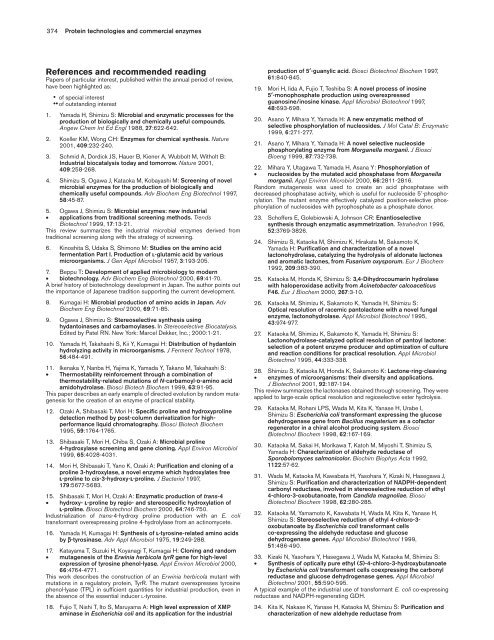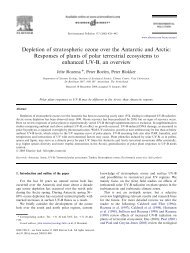Industrial microbial enzymes: their discovery by screening and use ...
Industrial microbial enzymes: their discovery by screening and use ...
Industrial microbial enzymes: their discovery by screening and use ...
You also want an ePaper? Increase the reach of your titles
YUMPU automatically turns print PDFs into web optimized ePapers that Google loves.
374 Protein technologies <strong>and</strong> commercial <strong>enzymes</strong><br />
References <strong>and</strong> recommended reading<br />
Papers of particular interest, published within the annual period of review,<br />
have been highlighted as:<br />
of special interest<br />
of outst<strong>and</strong>ing interest<br />
1. Yamada H, Shimizu S: Microbial <strong>and</strong> enzymatic processes for the<br />
production of biologically <strong>and</strong> chemically <strong>use</strong>ful compounds.<br />
Angew Chem Int Ed Engl 1988, 27:622-642.<br />
2. Koeller KM, Wong CH: Enzymes for chemical synthesis. Nature<br />
2001, 409:232-240.<br />
3. Schmid A, Dordick JS, Hauer B, Kiener A, Wubbolt M, Witholt B:<br />
<strong>Industrial</strong> biocatalysis today <strong>and</strong> tomorrow. Nature 2001,<br />
409:258-268.<br />
4. Shimizu S, Ogawa J, Kataoka M, Kobayashi M: Screening of novel<br />
<strong>microbial</strong> <strong>enzymes</strong> for the production of biologically <strong>and</strong><br />
chemically <strong>use</strong>ful compounds. Adv Biochem Eng Biotechnol 1997,<br />
58:45-87.<br />
5. Ogawa J, Shimizu S: Microbial <strong>enzymes</strong>: new industrial<br />
• applications from traditional <strong>screening</strong> methods. Trends<br />
Biotechnol 1999, 17:13-21.<br />
This review summarizes the industrial <strong>microbial</strong> <strong>enzymes</strong> derived from<br />
traditional <strong>screening</strong> along with the strategy of <strong>screening</strong>.<br />
6. Kinoshita S, Udaka S, Shimono M: Studies on the amino acid<br />
fermentation Part I. Production of L-glutamic acid <strong>by</strong> various<br />
microorganisms. J Gen Appl Microbiol 1957, 3:193-205.<br />
7. Beppu T: Development of applied microbiology to modern<br />
• biotechnology. Adv Biochem Eng Biotechnol 2000, 69:41-70.<br />
A brief history of biotechnology development in Japan. The author points out<br />
the importance of Japanese tradition supporting the current development.<br />
8. Kumagai H: Microbial production of amino acids in Japan. Adv<br />
Biochem Eng Biotechnol 2000, 69:71-85.<br />
9. Ogawa J, Shimizu S: Stereoselective synthesis using<br />
hydantoinases <strong>and</strong> carbamoylases. In Stereoselective Biocatalysis.<br />
Edited <strong>by</strong> Patel RN. New York: Marcel Dekker, Inc.; 2000:1-21.<br />
10. Yamada H, Takahashi S, Kii Y, Kumagai H: Distribution of hydantoin<br />
hydrolyzing activity in microorganisms. J Ferment Technol 1978,<br />
56:484-491.<br />
11. Ikenaka Y, Nanba H, Yajima K, Yamada Y, Takano M, Takahashi S:<br />
• Thermostability reinforcement through a combination of<br />
thermostability-related mutations of N-carbamoyl-D-amino acid<br />
amidohydrolase. Biosci Biotech Biochem 1999, 63:91-95.<br />
This paper describes an early example of directed evolution <strong>by</strong> r<strong>and</strong>om mutagenesis<br />
for the creation of an enzyme of practical stability.<br />
12. Ozaki A, Shibasaki T, Mori H: Specific proline <strong>and</strong> hydroxyproline<br />
detection method <strong>by</strong> post-column derivatization for highperformance<br />
liquid chromatography. Biosci Biotech Biochem<br />
1995, 59:1764-1765.<br />
13. Shibasaki T, Mori H, Chiba S, Ozaki A: Microbial proline<br />
4-hydroxylase <strong>screening</strong> <strong>and</strong> gene cloning. Appl Environ Microbiol<br />
1999, 65:4028-4031.<br />
14. Mori H, Shibasaki T, Yano K, Ozaki A: Purification <strong>and</strong> cloning of a<br />
proline 3-hydroxylase, a novel enzyme which hydroxylates free<br />
L-proline to cis-3-hydroxy-L-proline. J Bacteriol 1997,<br />
179:5677-5683.<br />
15. Shibasaki T, Mori H, Ozaki A: Enzymatic production of trans-4<br />
• hydroxy- L-proline <strong>by</strong> regio- <strong>and</strong> stereospecific hydroxylation of<br />
L-proline. Biosci Biotechnol Biochem 2000, 64:746-750.<br />
<strong>Industrial</strong>ization of trans-4-hydroxy proline production with an E. coli<br />
transformant overexpressing proline 4-hydrolylase from an actinomycete.<br />
16. Yamada H, Kumagai H: Synthesis of L-tyrosine-related amino acids<br />
<strong>by</strong> β-tyrosinase. Adv Appl Microbiol 1975, 19:249-288.<br />
17. Katayama T, Suzuki H, Koyanagi T, Kumagai H: Cloning <strong>and</strong> r<strong>and</strong>om<br />
• mutagenesis of the Erwinia herbicola tyrR gene for high-level<br />
expression of tyrosine phenol-lyase. Appl Environ Microbiol 2000,<br />
66:4764-4771.<br />
This work describes the construction of an Erwinia herbicola mutant with<br />
mutations in a regulatory protein, TyrR. The mutant overexpresses tyrosine<br />
phenol-lyase (TPL) in sufficient quantities for industrial production, even in<br />
the absence of the essential inducer L-tyrosine.<br />
18. Fujio T, Nishi T, Ito S, Maruyama A: High level expression of XMP<br />
aminase in Escherichia coli <strong>and</strong> its application for the industrial<br />
production of 5′-guanylic acid. Biosci Biotechnol Biochem 1997,<br />
61:840-845.<br />
19. Mori H, Iida A, Fujio T, Teshiba S: A novel process of inosine<br />
5′-monophosphate production using overexpressed<br />
guanosine/inosine kinase. Appl Microbiol Biotechnol 1997,<br />
48:693-698.<br />
20. Asano Y, Mihara Y, Yamada H: A new enzymatic method of<br />
selective phosphorylation of nucleosides. J Mol Catal B: Enzymatic<br />
1999, 6:271-277.<br />
21. Asano Y, Mihara Y, Yamada H: A novel selective nucleoside<br />
phosphorylating enzyme from Morganella morganii. J Biosci<br />
Bioeng 1999, 87:732-738.<br />
22. Mihara Y, Utagawa T, Yamada H, Asana Y: Phosphorylation of<br />
• nucleosides <strong>by</strong> the mutated acid phosphatase from Morganella<br />
morganii. Appl Environ Microbiol 2000, 66:2811-2816.<br />
R<strong>and</strong>om mutagenesis was <strong>use</strong>d to create an acid phosphatase with<br />
decreased phosphatase activity, which is <strong>use</strong>ful for nucleoside 5′-phosphorylation.<br />
The mutant enzyme effectively catalyzed position-selective phosphorylation<br />
of nucleosides with pyrophosphate as a phosphate donor.<br />
23. Schoffers E, Golebiowski A, Johnson CR: Enantioselective<br />
synthesis through enzymatic asymmetrization. Tetrahedron 1996,<br />
52:3769-3826.<br />
24. Shimizu S, Kataoka M, Shimizu K, Hirakata M, Sakamoto K,<br />
Yamada H: Purification <strong>and</strong> characterization of a novel<br />
lactonohydrolase, catalyzing the hydrolysis of aldonate lactones<br />
<strong>and</strong> aromatic lactones, from Fusarium oxysporum. Eur J Biochem<br />
1992, 209:383-390.<br />
25. Kataoka M, Honda K, Shimizu S: 3,4-Dihydrocoumarin hydrolase<br />
with haloperoxidase activity from Acinetobacter calcoaceticus<br />
F46. Eur J Biochem 2000, 267:3-10.<br />
26. Kataoka M, Shimizu K, Sakamoto K, Yamada H, Shimizu S:<br />
Optical resolution of racemic pantolactone with a novel fungal<br />
enzyme, lactonohydrolase. Appl Microbiol Biotechnol 1995,<br />
43:974-977.<br />
27. Kataoka M, Shimizu K, Sakamoto K, Yamada H, Shimizu S:<br />
Lactonohydrolase-catalyzed optical resolution of pantoyl lactone:<br />
selection of a potent enzyme producer <strong>and</strong> optimization of culture<br />
<strong>and</strong> reaction conditions for practical resolution. Appl Microbiol<br />
Biotechnol 1995, 44:333-338.<br />
28. Shimizu S, Kataoka M, Honda K, Sakamoto K: Lactone-ring-cleaving<br />
• <strong>enzymes</strong> of microorganisms: <strong>their</strong> diversity <strong>and</strong> applications.<br />
J Biotechnol 2001, 92:187-194.<br />
This review summarizes the lactonases obtained through <strong>screening</strong>. They were<br />
applied to large-scale optical resolution <strong>and</strong> regioselective ester hydrolysis.<br />
29. Kataoka M, Rohani LPS, Wada M, Kita K, Yanase H, Urabe I,<br />
Shimizu S: Escherichia coli transformant expressing the glucose<br />
dehydrogenase gene from Bacillus megaterium as a cofactor<br />
regenerator in a chiral alcohol producing system. Biosci<br />
Biotechnol Biochem 1998, 62:167-169.<br />
30. Kataoka M, Sakai H, Morikawa T, Katoh M, Miyoshi T, Shimizu S,<br />
Yamada H: Characterization of aldehyde reductase of<br />
Sporobolomyces salmonicolor. Biochim Biophys Acta 1992,<br />
1122:57-62.<br />
31. Wada M, Kataoka M, Kawabata H, Yasohara Y, Kizaki N, Hasegawa J,<br />
Shimizu S: Purification <strong>and</strong> characterization of NADPH-dependent<br />
carbonyl reductase, involved in stereoselective reduction of ethyl<br />
4-chloro-3-oxobutanoate, from C<strong>and</strong>ida magnoliae. Biosci<br />
Biotechnol Biochem 1998, 62:280-285.<br />
32. Kataoka M, Yamamoto K, Kawabata H, Wada M, Kita K, Yanase H,<br />
Shimizu S: Stereoselective reduction of ethyl 4-chloro-3oxobutanoate<br />
<strong>by</strong> Escherichia coli transformant cells<br />
co-expressing the aldehyde reductase <strong>and</strong> glucose<br />
dehydrogenase genes. Appl Microbiol Biotechnol 1999,<br />
51:486-490.<br />
33. Kizaki N, Yasohara Y, Hasegawa J, Wada M, Kataoka M, Shimizu S:<br />
• Synthesis of optically pure ethyl (S)-4-chloro-3-hydroxybutanoate<br />
<strong>by</strong> Escherichia coli transformant cells coexpressing the carbonyl<br />
reductase <strong>and</strong> glucose dehydrogenase genes. Appl Microbiol<br />
Biotechnol 2001, 55:590-595.<br />
A typical example of the industrial <strong>use</strong> of transformant E. coli co-expressing<br />
reductase <strong>and</strong> NADPH-regenerating GDH.<br />
34. Kita K, Nakase K, Yanase H, Kataoka M, Shimizu S: Purification <strong>and</strong><br />
characterization of new aldehyde reductase from




